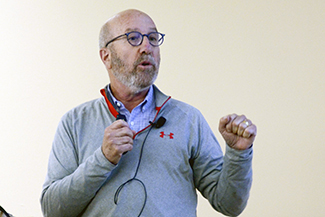Indexed for Profit
The swine industry uses an economic-based index tool to further selection gains.
by Kaci Foraker, editorial intern
BROOKINGS, S.D. (June 20, 2019) — Unique to the swine industry, indexes are the main evaluation tool used to select for the most valuable pigs to add to an operation. At the 2019 Beef Improvement Federation symposium, Scott Newman from Genus ABS described how indexes and models are used for pig selection.
“The index is composed of breeding values and economic weightings,” said Newman. “A lot of what PIC (Pig Improvement Company) does is based on male and female lines to mate and develop crossbred products to use for production of market progeny. We have very specific maternal and terminal lines.”

Scott Newman
Scott Newman of Genus ABS described how indexes and models are used for selection in the swine industry. [Photo by Kaci Foraker]
When purchasing a boar, the buyer doesn’t get a sale book; they may only see index values or an anonymous pedigree, said Newman. In an example, he noted that five bulls could each have different values for five selected expected progeny differences (EPDs), but all have the same index value. That’s where weighting those values in an index plays a role in what drives the operation’s selection criteria.
Using indexes for profit
To analyze profit for an operation, it needs to identify its costs and expenses in a value format and utilize a profit equation to create a bioeconomic model. Newman uses an equation that accounts for the pig’s value, costs of gain and costs of keeping a sow in the operation.

Profit equations can have additional factors included if an operation needs to involve other costs or expenses. In the swine industry, Newman said, it’s easier to identify values for costs and expenses because pigs are in a mostly controlled environment.
To run a bioeconomic model, the first step is to add values into the equation and record the outcome, which is profit per animal. Next, increase one desired trait by some unit and run the model again. Then figure the difference between the two profit-per-animal values to determine the marginal economic value (MEV) of changing that trait.
In a maternal-line index example, Newman calculated the MEV and weighted more emphasis on female desired gains. Due to discounted expression of genetics from the dam vs. the sire, there are negative correlations or low heritability among certain traits.
“We can utilize desired gains to provide us certain predetermined values or target values in response, while maximizing response in other traits,” said Newman. “To me it’s about balancing the emphasis we want to put on those traits within biological limitations. Is it optimal? No, it’s suboptimal, because I am going to lose response in some traits at the expense of others. But I still feel desired gains is very valuable if you keep in mind the biological limitations of the animals you are working with.”
The 2019 BIF Annual Convention was hosted by South Dakota State University and the South Dakota Beef Breeds Council June 18-21 at the University Comfort Suites and Convention Center in Bookings. ANGUS MEDIA® provides comprehensive online coverage of the event at www.BIFconference.com. Visit the Newsroom for summaries, proceedings, PowerPoints, video and/or audio of the sessions and the Awards page for announcements and photos of award winners.
Editor’s Note: This summary was written under contract or by staff of ANGUS MEDIA®. Through an agreement with the Beef Improvement Federation,
we encourage reprinting of the articles to those who will adhere to the
reprint guidelines available on this site. Please review those
guidelines or contact Shauna Rose Hermel,
editor, at 816-383-5270. PowerPoints are posted with permission of the
presenter and may not be reproduced in whole or in part without the
express permission of the presenter. We welcome educational venues and
cattlemen to link to this site as a service to their audience.
For questions about this site, or to notify us of broken links, click here. Look for additional coverage in the Angus Journal, the Angus Beef Bulletin, the Angus Journal Daily, the Angus Beef Bulletin EXTRA and Angus TV.


